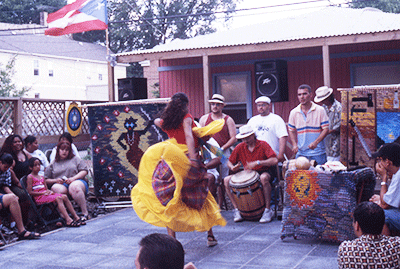
In 1997 after decades of displacement, Chicago’s Puerto Rican community staked their claim to an eight block stretch of Division Street between Western and California avenues. In the mid-1990s, two issues coalesced to stir a community movement. The first was the refusal of the Chicago Park District to allow a statue of Don Pedro Albizu Campos to be placed within Humboldt Park, which is part of Chicago’s historic boulevard system. The second was the desire and savvy knowledge of local activists to stake a neighborhood claim by both owning property and creating culturally specific visual signifiers. At the time, this stretch of Division Street was dotted with vacant lots, one of which was purchased by the Puerto Rican Cultural Center and developed as a community cultural space with the help of archi-treasures.
The refusal of the Chicago Park District to support the installation of a statue honoring Albizu Campos clearly demonstrates a politics of dis-belonging. Like many urban neighborhoods, Humboldt Park has a layered history where different ethnic groups have gained, given up, and lost control of the space. These transitions are memorialized in the park itself with a diverse selection of public art, most of which are statues that were purchased and placed by cultural groups. The Norwegian community supported a statue of Leif Erikson, and the German community erected statues of Alexander von Humboldt and Fritz Reuter. But when the Puerto Rican community sought to insert Albizu Campos into this mix, they were met with resistance. The unacceptable politics of Puerto Rico’s independence movement overrode the city’s tradition of allowing ethnically specific representations in the park.

La Casita de Don Pedro Albizu Campos was one of four projects in archi-treasures’ 1996-1997 pilot program. The Garden Gallery Project, in which youth identified an underutilized outdoor space in their own community then redesigned it as a much-needed community gathering space. An archi-treasures team comprised of architects, artists, and educators worked with high school students as they learned skills in site assessment and measurement, scale drawing and model making, participatory design and critique, and finally, presentation.

Creative placemaking should prioritize creatively engaging indigenous communities rather than emphasizing strategies of artist engagement that result in gentrification and displacement. Without intentional, authentic community engagement, a place will retain too much of its relationship to the concepts and plans of outside professionals who are driving the project.
As an arts-based organization, archi-treasures strongly advocates for the inclusion of artists in community development, but also challenges the field of creative placemaking to question and define the artist’s role and to achieve a deeper understanding of the ingredients that comprise successful placemaking and a sense of belonging.
Photo credits, from top to bottom: A statue of Don Pedro Albizu Campos; a cultural event at La Casita de Don Pedro; and a “before” photo of the lot where La Casita is now located. All courtesy of archi-treasures.






Comments